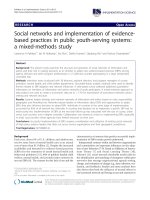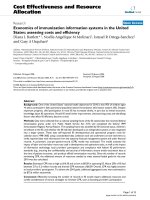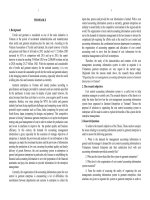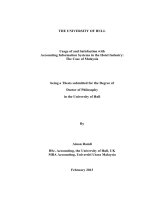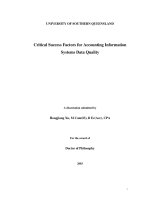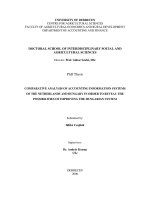ANALYSING AND DESIGNING ACCOUNTING INFORMATION SYSTEMS IN PUBLIC HOSPITALS
Bạn đang xem bản rút gọn của tài liệu. Xem và tải ngay bản đầy đủ của tài liệu tại đây (278.76 KB, 27 trang )
MINISTRY OF EDUCATION AND TRAINING
UNIVERSTY OF DA NANG
----------
HUYNH THI HONG HANH
ANALYSING AND DESIGNING
ACCOUNTING INFORMATION SYSTEMS
IN PUBLIC HOSPITALS
MAJOR: ACCOUNTING
CODE: 62.34.30.01
SUMMARY OF DOCTORAL DISSERTATION
Danang, 2015
The dissertation to be completed in: The University of
Danang
Scientific supervisors:
1. Prof. Dr. Truong Ba Thanh
2. Assoc.Prof. Dr. Nguyen Manh Toan
First judge: Dr. Ha Thi Ngoc Ha
Second judge: Assoc.Prof. Dr. Trinh Van Son
Third judge: Dr. Doan Ngoc Phi Anh
The thesis is going to be presented at the dissertation
valueing board.
Time: 14:00 date 1 month 2 year 2015
Place: The University of Da Nang, 41 Le Duan, Danang.
For more information, the dissertation can be found at:
- National Library of Vietnam
- Learning and Information Resource Center - the
Universty of Danang.
LIST OF ANNOUNCED SCIENTIFIC ACHIVEMENTS
1. Huynh, T.H. Hanh, Nguyen M. Toan, (2014), “New Requirements for AIS
in public hospitals”, Journal of Economics and Development, No 204 (II),
91-98.
2. Truong B. Thanh, Huynh T.H. Hanh (2014), “Inadequacies in finance
autonomy in public hospitals-A cost analysis based on performance level
approach”, Journal of Economics and Development, No 200 (II), 35-39
3. Nguyen M. Toan, Huynh T.H. Hanh (2014), “Accounting for for – profit
business in public hospitals – Actual situation and solutions” Proceeding of
Workshop on Public Acounting in the integration into the global economy”,
Ho Chi Minh City Economics University, 119-130.
4. Huynh, T.H. Hanh, Nguyen M. Toan (2013), “An Integrted and
Multidimensional Approach on AIS”, Journal of Economics and
Development, No 192, 80-87.
5. Huynh, T.H. Hanh, Nguyen M. Toan (2013), “Evaluation of Efficient
AIS”, Journal of Accounting and Auditing, No 117, 11-15.
6. Huynh T.H Hanh (2012), “Cycle approach: A solution to the perfection
of AIS in public hospitals”, Journal of Science and Technology, No 1 (50),
109-116.
7. Huynh T.H Hanh (2012) “Perfecting AIS in hospitals oriented by
Integrated Management Solution”, Journal of Science and Technology, No 9
(58), 40-46.
8. Nguyen M. Toan, Huynh T.H. Hanh (2012), “Criteria used to evaluate the
quality of Accounting Software”, Proceeding of Workshop on Accounting
and Auditing in Integration and Reform, UD, 136-143
9. Huynh T.H Hanh (2012), “The application og Integrated Management
Solution to perfect AIS in hospital”, Proceeding of Workshop IT and IT
Aplication in different area, UD, 136-143.
10. Huynh, T.H. Hanh, Nguyen M. Toan (2011), “Controlling and Ensuring
Safety of computer-based AIS”, Journal of Science and Technology, No 44,
177-195.
11. Nguyen M. Toan, Huynh T.H. Hanh (2011), “Organising database for
computer-based AIS”, Journal of Accounting and Auditing, No 91, 31-37.
12. Nguyen Manh Toan, Huynh Thi Hong Hanh (2010), “Duplicated entry
and solutions in accounting sofware”, Journal of Accounting, No 87, 19-22
INTRODUCTION
i. Rationale
Public hospitals play a crucial role in providing health services, training
and researching in medical area. In order to motivate public hospitals’
activities towards the efficiency and sustainable development, the
Government has authorized a particular financial mechanism as well as
medical-fee policies to fit the public hospitals’ context. This will obviously
lead to basic changes in accounting information systems (AIS) in public
hospitals. AIS’s function is not merely to process the records or calculate
expenses, but more importantly it has to be able to provide the leaders with
fundamental information so that they can operate every single hospital
effectively and optimally. In addition to providing and handling with the
accounting information under the demands of the managers, AIS has to focus
on management accounting, especially the cost management so as to
improve the hospitals’ operating efficiency. Apart from this, AIS has to be a
crucial part which is inseparable from the overall management of the
hospitals, an important bridge linking functional divisions in the hospitals.
Recognising the importance of AIS in public hospitals in implementing
the financial autonomy, people involving in financial activities should
foresee the necessity of doing an in-depth research about AIS in order to
identify new demands, analyse and evaluate the current management system
with the aim at designing and building a suitable AIS, which performs its
functions at maximum. For this reason, the topic “Analysing and designing
AIS in public hospitals” is chosen in this doctoral dissertation.
ii. Aims of study:
The analysis and design of AIS is based on IT application facilitating the
effective financial management and operation in public hospitals in the
current finance autonomy mechanism.
iii. Subjects and Scope of Study:
- AIS in public hospitals using IT applications.
- Public hospitals which rank the third or over.
- Attention will be first paid to diagnosing and treating
iv. Methodology:
Both quantitative and qualitative approaches are used to achieve the aims
of study.
v. Contributions of the study:
The theoretical contributions include:
(1) Systemnization and development of theoretical foundations for AIS
in hospitals.
(2) Identification and organization of four accounting cycles in public
hospital i.e supplying, treatment, collecting medical-fee and financing.
(3) Building the model of factors affecting the success of AIS in hospitals.
The practical contributions include:
(1) Identifying new requirements for AIS in public hospitals
(2) Organising cost collection in the application of information
technology subject to the combination between finance accounting
and management accounting.
(3) Designing in detail AIS in public hospitals in conjunction with the
application of information technology oriented by integrated
management solutions
vi. Design of Study:
Apart from Introduction and Conclusion, the paper is divided into four
chapters.
Chapter 1: Literature review of AIS in hospitals
Chapter 2: Methodology
Chapter 3: Findings of AIS analysing and identification of new
requirements for AIS in public hospitals
Chapter 4: Designing AIS in public hospitals
CHAPTER 1. LITERATURE REVIEW OF AIS IN HOSPITALS
1.1 Literature review of AIS
1.1.1. Nature of AIS
The understanding of the nature of AIS can be approached by many ways
as follows.
- The approach to object accounting is the most popular way.
- The approach to the accounting organization and accounting
mechanism, which focuses on people is a popular one.
- The approach functioning as an information system (IS), regarding AIS
as a part of IS which has input, process and output.
- The approach which is made via the components of AIS including: (1)
human, (2) procedure and information process, (3) data about its operation,
(4) IT platform which consists of computers and information linking devices,
(5) accounting software including accounting data and (6) internal
controling tools
- The approach based on the cycle, aiming to the objects using the
accounting information. This is an approach consistent with the IT applying
conditions.
1.1.2. The role of AIS
Providing accounting information to facilitate strategic planning,
management control and operation control.
1.1.3. Ways of studying AIS
Studies related to AIS assessment
- Assessing AIS relying on the quality of the output information.
- Assessing AIS through the measurement of functions.
- Assessing based on the satisfaction of information users.
Studying AIS in the association with ERP application
- Analysing the benefits of ERP application: improving the quality of
accounting information and the accounting efficiency.
- Analysing data security and decline in the efficiency of internal
control system.
Studies related to analyzing and designing AIS
The participation of users plays a crucial role in the AIS design process.
1.2. Literature review of AIS in hospitals
1.2.1. An overall introduction of hospitals
The structure of hospitals is usually divided into 3 major devisions:
logistics, clinical practice and pre-clinical practice (PC).
1.2.2. AIS in the application of Integrated Management Solution
- The organization of AIS has to attach much importance to building the
relationships with other IT functions.
- Organizing all the activities professionally.
1.2.3. Researches on AIS in hospital
Researches on hospital AIS focus on assessing AIS, ERP application with
the hospital’s characteristics s as well as modern accounting methods
assisting the cost control and improving the operation effectiveness of the
hospital.
1.3. Literature review of the public hospitals’ AIS in Vietnam
The researches have portrayed a paranamic picture of the AIS
organisation in public hospitals in Vietnam, recognising the improvement of
AIS and putting forward some measures to improve AIS on the financial
accouting side and taking the first step in implementing accounting
management and IT application.
CHAPTER 2. METHODOLOGY
2.1. Context and hypotheses
2.1.1. Context
- There are shortcomings in the implementation of financial autonomy
mechanism at public hospitals
- Promulgating regulations on the operation and financial mechanism of
public health centers.
- Building the procedure of adjusting health service prices by calculating
the cost fully and correctly.
- Aiming to the payment-based-on-the- health case.
2.2.2. Hypotheses
- Hypothesis 1. AIS needs to provide new information to support the
management and operation of hospitals.
- Hypothesis 2. Methods of handling AIS’s information have to be based
on the IT platform and be directed to the overall hospital managing solution.
- Hypothesis 3. Information quality, system quality and the awareness of
the benefits of AIS have mutual impact and affect the success of AIS in the
hospitals (assessment based on the users’ satisfaction).
2.2 Methodology
2.2.1. Quantititive Research Methodology:
Case study research is used to aim at an understanding of operations in
public hospitals. In addition, focus groups are used to record
experts’opinions about research hypotheses, which lays the foundation for
designing the questionnaire.
2.2.2. Qualitative Research Methodology
The respondents are managers at different levels in public hospitals.
- Samples: 238 questionnaires are delivered to executive managers and
125 to accountants.Qualitative Research Methodology includes descriptive
statistics, EFA, CFA, SEM.
2.3. Methodology of designing AIS
In accordance with current AIS and the tendency of designing current
AIS, the chosen methodology of designing AIS is the objects-oriented one.
CHAPTER 3: FINDINGS OF AIS ANALYSING AND IDENTIFYING
NEW REQUIREMENTS FOR AIS IN PUBLIC HOSPITALS
3.1. Analysing relationships between AIS and IS of other functions in
public hospitals in the direction of cycle approach
3.1.1. Supply cycle
Supply cycle in hospitals has two main functions namely purchasing and
making payments to suppliers. These include (1) Making supply chain (2)
Organising bidding (3) Receiving medicines/ appliances and storing (3)
Monitoring payments
The functions of AIS consist of accounting for inventory, monitoring and
making payments to suppliers.
3.1.2. Cycle of examining and treating patients
Cycle of examining and treating patients is the bridge connecting feecollection and supply including receiving patients, examining, treating outpatients and in-patients, doing check-out.
AIS is in charge of accounting, allocating expenses related to activities
of examining and treating.
3.1.3. Cycle of collecting medical fee
Cycle of collecting medical fee calculates the exact fee for each patient
and collects it. This includes four steps namely calculating fee, collecting
fee, creating the spreadsheet, recording and clearing the account with the
medical insurance company on the medical fee of each insured patient.
3.1.2. Cycle of financial activities
This cycle involves receiving and using the budget, putting up capital and
using the capital raised from external resources, calculating employees’
salary and their financial contributions extracted from the salary, setting the
budget for buying fixed assets, processing the records, preparing balance
sheets, identifying and analyzing operation result of hospitals.
3.2. Analysing the correlation between components of AIS basing on the
overall and multidimensional approach
In order to provide a thorough understanding of AIS, the research is done
not just by individual approaches but systematic ones. This dissertation will
introduce a new approach which presents overall and multidimensional
characteristics. Furthermore, the dissertation will briefly and visually
describe the correlation and unity of AIS’s components. This lays the
foundation for designing AIS in hospitals.
3.2.1. Relation between operation cycle and accounting objects
A lot of accounting objects get involved in each operation procedure in
hospitals. They are monitored, accounted and provided with information by
the correspondent acountant. On the contrary, the change of any accounting
objects will have impact on a specific operation cycle and functional
departments in hospitals. The recognition of this relation is of great
importance in organizing AIS in cycles and effectively coordinating the
operation of accounts department and of other functional departments,
especially in association with IT applications.
3.2.2. Relation between accounting objects with resources, method and
procedure of accounting
All activities carried out in a hospital are part of a specific cycle and each
cycle correlates with accounting activities. Accountants collect, check
documents, classify them, record them and report the concerned information
about accounting subjects with the help of technology. In the whole process,
internal controlling tools are also used to promote the implementation of
each cycle aiming at achieving the hospital’s goals.
3.3. Identifying new requirements for AIS
3.3.1. Content of supplementary information
The findings show that supplementary information includes information
about selling price of each medical service, each patient and information
about examining and treating service , about medical fee and derivative
expenses of each department, about inventory of medicines and each
patient’s accummulated fee at a specific time.
3.3.2. Handling information
In addition to the application of accounting software, the findings
represent the necessity of handling information in accordance with data link
among functional departments in hospitals. This acts as premise directing to
the application of overall management in hospitals.
Hypothesis 2 is acceptable.
3.3.3. Evaluation of AIS in hospitals at present
- Actual situation of providing information about medical fee to patients:
Information about medical fee of groups of patients is well –handled at
hospitals. Some are able to provide information about medical fee to every
department and accummulated fee of each patient at any time. However, a
few public hospitals have not carried out processing and supplying
information on medical fee in accordance with code of patients very well.
This leaves a room for our dissertation to put forward some measures in
organising AIS meeting the requirement.
- Actual situation of accounting, allocating and providing information on
expenses: The accounting of expenses on medicines, medical appliances and
salary is done well at public hospitals, However, some hospitals have not
done the accounting and allocated indirect costs and so there is a high
proportion of hospitals unfulfilling the setting of selling price of each
medical service.
- Actual situation of accounting the health service activities: 90% of
public hospitals offering health services have collected and separately
accounted the revenues from such activities. However, nearly 30% of
hospitals have not yet identified the actual cost of the health services.
- Actual situation of IT application: The survey results show that most of
the public hospitals have applied the accounting software and done well in
automatically setting medicine prices and service price. However, the data
link between the accounting and pharmaceutical department, pharmaceutical
depart- ment and the department in charge of treating patients, the
department in charge of treating patients and accounting department has not
been paid attention to. Only 20% of the hospitals in the survey have applied
the overall hospital management solution.
3.3.4. Research result on the relationship between the ability of
providing information and handling information
The analysis of the Pearson correlation coefficients between the overall
hospital management software and the cost of every single case can assert
that the overall management software application is one of the important
solutions supporting the collection, processing and providing accounting
information accounting information in accor-dance with requirements in
management.
3.4. Research result on factors affecting the success of AIS in public
hospitals
3.4.1. Scale assessing
- The Cronbach Alpha coefficients of the scales are qualified.
- The conditions of EFA show that the data are consistent with exploring
factor analysis.
- The factor analysis has identified 5 groups. They include information
quality, system quality, function guarantee, awareness of utility and
satisfaction.
- Scale testing by EFA shows that the model is consistent with real data.
All of the scales meet the requirements of composite reliability, extracted
variance and converged values.
3.4.2. Model testing and the research hypotheses
SEM result shows that this model is compatible with the real data. There
are 2 hypotheses of the model being rejected, the other relationships have
the statistical meanings.
3.4.3. Implications of research results
- A successful AIS has to be qualified to implement the functions of AIS
namely informing and controlling.
- The quality of the information handling system has to be high so as to
provide qualified information and help guarantee the AIS functions to be
well implemented.
- To improve the quality of the system, the first thing to do is to raise
awareness of the leaders of the role of AIS.
3.5. Orientation of designing AIS based on the research results
- The design of AIS has to be directed to the provision of new accounting
information based on actual needs.
- The design of AIS has to be based on the IT application in the direction
of overall hospital management solutions.
- The design of AIS in conjunction with IT application has to follow the
accounting cycles.
CHAPTER 4. DESIGNING THE AIS IN PUBLIC HOSPITALS 4.1.
Establishing the codes for the objects
4.1.1. Exploiting and using the standardized codes of the industry
Hospitals should follow the standardized codes of the medical industry
such as the active medicine code, health management code, procedure
surgical code, health insurance card code, etc.
4.1.2. Establishing the hospital’s own codes
To manage the specific objects relevant to the characteristics of managing
objects as well as the operation and the size of hospital, specific codes need
to be set. As every object may have a lot of different characteristics which
need to be managed, codes in hospitals should be designed based on the code
pairing or decentralization method.
4.2. Designing AIS in the supply cycle
4.2.1. Organizing the database
Establishing the file DANH_MUC_THUOC_VAT_TU to store and
update the information of the content and characteristics of every medicine,
medical appliance. Additionally, each file should consist of some fields as
follows:
- ID_TY_LE_BHYT_TH_TOAN: manage information on the ratio of
payment made by medical insurance company per each kind of medicine and
medical supplies.
- ID_NOI_DUNG_VIEN_PHI: facilitating the classification of different
costs so as to make spreadsheet of healthcare fee)
- SL_TON_KHO_TOI_THIEU: showing the minimum inventory of each
kind of medicine and medical supplies.
- SL_DAT_HANG_TOI_UU: giving information on the maximum
number of orders for each kind.
- SL_TON_KHO_HIEN_TAI, which is updated after each entry is
recorded, represents the actual inventory of each kind of medicine and
medical supplies at a definite time.
4.2.2. Organising data and handling the procedure of storing medicine
and medical supplies.
- Pharmaceutical Department/Machine-Medical supplies Depart-ment:
is in charge of checking, warehousing, updating data and generating
warehouse receipts. Detailed data about warehousing of each kind of
medicine and medical supplies will be entered in file PHIEU_NHAP_KHO
(backing up information on warehouse receipts) and file CHI_TIET_PNK
(showing the number, unit price of each medicine stored in the warehouse).
- Accounting Department: is responsible for checking warehouse
receipts, updating and supplementing clauses and backing up information in
“warehouse of general data” which consists of two files namely NHAT_KY
and CHI_TIET_NK. NHAT_KY file is linked with CHI_TIET_NK file via
ID_CHUNG_TU field and functions as a general data warehouse handling
the synthetic accounting.
In order to monitor suppliers, TK 3311 is used to update information in
field TK_NO/ TK_CO located in file CHI_TIET_NK, ID_NHA_
CUNG_CAP, which is registered in CHI_TIET_TKNO or
CHI_TIET_TKCO so as to do the accounting of suppliers’ creditcontrolling.
4.3. Designing AIS in the treatment cycle
The basic function of AIS in the cycle of health examination and
treatment is to note and do the accounting of costs which are related to
examining and treating patients..
4.3.1. Principles of organizing database and accounting costs
Principle of organizing database
- Every patient is controlled by an ID_BENH_NHAN
- For every period of treatment given to each patient: ID_BENH_ AN is
used
- For every period of treatment when patient is examined several times:
ID_LAN_KHAM is used.
- For everytime of examing using specified medicines: subclinical
medicines and services are used
- Each specified examination can be carried out by different functional
departments in hospitals.
Designing the cost list
Designing the cost list is an important part to do the accounting,
aggregation and cost allocation. All the costs for examnining and treating
including direct and indirect cost. Besides, in compliance with the regulation
of combining financial accounting and management accounting, the design
of cost list in public hospitals needs to be attatched to the content table of
Government budget. In the list, each item of incurred cost content has to be
consistent with the title and subtitle of the content table of Government
budget.
The rules of accounting cost
Direct costs related to each patient, each type of medical technical
service, each department, each activity are all gathered directly. Account
6612 is used if the incurred costs related to each compulsory activity of
examining and treating and Account 631 is used if those related to examining
and treating on demand.
4.3.2. Designing IS to monitor each patient’s information
Information on patient is stored and managed in the file
HO_SO_BENH_NHAN, which belongs to the main field
ID_BENH_NHAN. The functional divisions are allowed to exploit and use
information on patient from this file.
4.3.3 Designing AIS of patients’ expenses on the basis of each
individual department
ID_GIUONG is used in the file DANH_MUC_GIUONG_ BENH to
identify patients receiving treatment at a specific ward under the control of
a specific department and their transfer to a different department or ward.
Along with organizing data file DANH_MUC_BUONG_BENH and
DANH_MUC_KHOA_ PHONG, the accounting of examination and
treatment costs at every department in-charge can be done. In addition,
organizing data file tin CHUYEN_KHOA_ BUONG leads to an efficient
management and provision of information about the process of transferring
patients from one department to another and from one ward to another within
a department.
4.3.4. Designing AIS of patient costs subject to each time of
examination
File ID_LAN_KHAM generated by the system itself in the file
KHAM_BENH is used to store general information and result of each time
of examination for out-patients, in-patients and boarding-patients.
4.3.5. Designing AIS of patients’ fee subject to each type of cost
- Organising the file tin CHI_DINH_THUOC to store information about
each type of medicine, blood, infusion, specified medical supplies, kinds of
medicine provided to patients in the field SO_LUONG_DUOC_CAP and
SO_LUONG_ CAP_CHO_BN in this file. This is a basic foundation for
accounting costs of medicines, blood, chemical, infusion employed in the
treatment given to each patient, doing the statistics of costs for each kind of
medicine.
Additionally, in the cycle of examination and treatment, the file
CHI_DINH_DVKT_CLS needs to be created to monitor the implementation
of instructions about specified technical as well as subclinical services
offered to patients. This aims at calculating incurred costs and then the price
of these services.
4.3.6. Designing AISt of patient cost subject to each treatment period
Each treatment period is monitored in the patient’s medical records, each
of which has ID_BENH_AN connected with the patient in each treatment
period. The number and kind of medicine or medical supplies in use is stored
in the file CHI_DINH_THUOC while the number and kind of medical
technical services is stored in the file CHI_DINH_DVKT_CLS. Information
on the ward, the bed in use can also be exploited from the files HO_SO_
BENH_AN, KHAM_BENH, CHUYEN_KHOA_BUONG. Based on the
link between file KHAM_BENH and HO_SO_BENH_AN, users can do
the statistics of kinds of medicine, medical supplies, technical and
subclinical services provided to each patient in each of their treatment
period.
4.3.7. Designing AIS of cost and selling price for each medical service
and each patient
The dissertation puts forward organizing the file CHI_TIET_
CHI_PHI_KCB to collect the incurred costs subject to cost central/ various
subjects for the sake of facilitating the accounting of costs and prices.
By forming the cost list in hopitals and linking data at different fields
ID_KHOA_PHONG and ID_DVKT_CLS, AIS is able to do the accounting
of each cost subject to each department. In this method, when accounting the
credits in Account 6612/631/Account 642 in the field TKNO of the file
CHI_TIET_ NK, the system requires updating the costs related to the arising
affairs, the departments in concern (cost central), technical and subclinical
services (cost subjects). Then these costs are stored in field ID_CHI_PHI,
ID_KHOA_PHONG
and
ID_DVKT_CLS
of
the
file
CHI_TIET_CHI_PHI_KCB.
With regard to allocating general costs, the dissertation suggests ways of
allocating costs using top-down approach, which sets priority for general
costs related to the departments as follows.
Step 1: Allocate costs of administrative management
Step 2: Allocate costs of equipment maintenance and sanitation
Sep 3: Allocate costs of pharmaceutical management
Step 4: Allocate costs of subclinical departments.
The procedure mentioned above will lead to the fact that the total incurred
costs are collected and allocated to all departments. The accounting of total
costs to subclinical departments, operation rooms along with the medical
services carried out brings about a basic foundation for setting price for each
medical service. Furthermore, the collection of private costs and allocation
of general costs to clinical treatment departments lays the foundation for
calculating the price for each patient.
4.4. Designing AIS in medical-fee collecting cycle
In order to support the collection of all incurred costs and then group
them in different categories so as to print out the list of examination and
treatment
costs,
the
dissertation
suggests
organizing
file
THANH_TOAN_RA_VIEN, where the data about medicine use, medical
supplies and medical services employed in the treatment will automatically
be updated into the file from the other files like CHI_DINH_THUOC and
CHI_DINH_DVKT_CLS.
Additionally,
in
the
file
DANH_MUC_THUOC_VTYT and DANH_MUC_DVKT_ CLS there is
the field TY_LE_BHYT_ TH_TOAN used to identify kinds of medicine,
medical supplies, technical and subclinical services which are fully-paid,
partly-paid or unpaid by the insurance company. This helps identifying the
fee that each patient and the insurance company have to pay. Apart from it,
the file THEO_DOI_TAM_UNG needs to be created to monitor advance
receipts and advance-return receipts.
Basing on the lists recording the collected fee, advance and advancereturn fee made at the end of the day, cash accountants write receipts and do
the synthetic accounting at the correspondent accounts.
In order to process the differences between receipts and payments for
each activity, accountants are supposed to write the own receipts and
entering them in Account Payable 111 / Account Receivable 5111 for the
fee fully paid by normal patients and partly fee paid by insured patients,
entering them in Account Payble111/ Account Receivable 531 for the fee
paid by out-patients.
4.5. Designing AIS in finance cycle
4.5.1. Designing AIS of salary
File DANH_MUC_NHAN_VIEN is organized to update and store
information about personnel management and important input information
such as employees’ salary level and allowances. This file also provides
information about employees’ Id.cards, bank accounts used to effect salary
payments. Furthermore, the field ID_KHOA_PHONG needs to be created
in this file to manage employees and account employees’ salary within each
department.
File LUONG_VA_THU_NHAP is organised to update, back up
information about salary and other payments to employees. In order to
account each of the salary costs subject to department/unit, when entering it
in the Account. Payable 6612/631/642 of the field TK_NO in the file
CHI_TIET_NK, the system requires updating the cost as “salary” in the
departments or units in concern and store it in field ID_CHI_PHI,
ID_KHOA_PHONG of file CHI_TIET_CHI_PHI_ KCB.
4.5.2. Designing AIS of fixed assets
File DANH_MUC_TSCĐ is organised to manage fixed assets. Apart
from general information about content, characteristics and actual condition
of fixed asstets, the classification based on main sources
(ID_NGUON_VON), purpose of use (ID_MUC_DICH_ SU_DUNG),
department-in-charge (ID_KHOA_PHONG) needs to be carried out. It
functions as a base for fixed asset management for the sake of identifying
the budget used in reinvesting fixed asset as well as figuring out the financial
results of hospitals’ trading operation.
- Fixed assets purchased from the state budget and used to fulfill the
hospital’s functional duties are accounted as depreciation and entered in the
Account Payable 466/ Account Receivable 214 at the end of financial year.
- Fixed assets originated from the state budget and only used to carry out
trading activities are accounted as depreciation and entered in the Account
Payable 631/ Account Receivable 214 monthly; accounted as depreciation
and entered in the Account Payable 466/ Account Receivable 431 at the end
of financial year.
- Fixed assets purchased from loan, trading budget or other resources and
used for for-profit business are accounted as depreciation, added to trading
costs and entered in the Account Payable 631/ Account Receivable 214
monthly or periodically. Accounted as depreciation and entered in the
Account Payable 466/ Account Receivable 431 at the end of financial year.
For the fixed assets which are originated from the state budget and used in
serving insured patients and patients-on-demand, allocation approach is
deployed to identify wear-and-tear value of fixed assets subject to each
activity logically calculated to cost.
Because of the complication in calculating and accounting fixed asset
depreciation, it is advisable to organize the file KHAU_HAO_ TSCĐ which
consists of field PHAN_BO identifying which fixed asset needs to be
invested in and field TIEU_THUC_PHAN_BO used to allocate each of the
fixed asset relevant to each activity.
4.5.3. Designing AIS to identify financial results
On the basis of accounting and allocating costs mentioned above, cost
accounting for each activity can be done (in Account 6612 or 631), in each
of which close monitoring to cost activity in each department or unit and to
receipts from each activity (accounted in Account 511 or 531) will be
performed. This proceeds a constant supervision on each activity done by
every department/ unit. The approach is beneficial to hospitals in identifying
the difference between receipts and payments in each activity done by every
department/ unit.
4.5.4. Designing AIS to provide accounting information
- Organise file SO_CAI which is used to print out the ledger and to
prepare financial reports and budget accounting report.
- Organize files containing special details such as CHI_TIET_ PNK,
CHI_TIET_PXK, CHI_TIET_CHI_PHI_KCB, THEO_DOI_ TAM_UNG
or organize detailed monitoring fields such as CHI_ TIET_TKNO,
CHI_TIET_TKCO in file CHI_TIET_NK. This helps to process, provide
and print out detailed accounting books on demand.
4.6. Recommendations for implementation AIS design in publib
hospitals
4.6.1. Difficulties
The implementation AIS design oriented by total management solutions
may face difficulties from the perception of hospital leadership, capacity of
worker force, the coordination of the functional units , IT infrastructure ...
4.6.2. Recommendations
- Review and complete the assigned work, clearly identify the specific
functions and responsibilities of each department.
- Perform analysis of business processes of the hospital to make the
requirements for AIS.
- Investment in IT infrastructure
- Upgrading of IT for employers.
- Select the method for designing software.
SUMMARY
Over the past years, the implementation of finance autonomy mechanism
has resulted in the need for a change in AIS so as to better promote the role
of AIS in efficient management and operation in public hospitals. The
dissertation “ Analysing and designing AIS in public hospitals” is written
based on a sound reasoning basis, primary and secondary database and a
combination of both quantitative and qualitative research method, which are
applied consistently with its aims and background. The dissertation can be
summarized as follows.
Results of the dissertation
- Synthesizing all of the researches on AIS.
- Identifying and organizing AIS in public hospitals with four cycles and
developing an overall and multidimensional approach about AIS in hospitals
- Establishing and testing model of factors affecting the success of AIS
in public hospitals via the AIS users’ satisfaction. Apart from three factors
namely information quality, system quality and awareness of the usefulness
of AIS, the research introduces the factor “task fulfillment” relevant to the
awareness of AIS and operation characteristics in Vietnamese hospitals.
- Conducting a survey on large scale with 200 respondents (who are
executive officers at different levels in hospitals) and employing appropriate
analysis methods to identify new requirements for information and ways of
handling information.
- Analyzing the ability to meet new requirements of AIS in public
hospitals via a survey conducted at 125 public hospitals nationwide. The
results acts as a useful base that helps managerial organizations in making
finance management policies, building mechanism for receipt-payment
monitoring, accounting state budget and building an accounting system
relevant to public hospitals’operation.
- Establishing operation procedure describing the relation between
functions and components in accounting cycle to aim at ensuring the
efficient collection, processing and provision of information.
- Designing codes, identifying the structure of files and the relation
among database files. The most important contribution is to suggest a
solution in managing and designing appropriate database files as well as
using accounts and method of analyzing the data to integrate finance
accounting with management accounting and so meeting the needs for
information of users.
New contributions of the dissertation
- Organising AIS in hospitals with a new approach – cycle approach,
which includes four cycles namely supply cycle, examination and treatment


